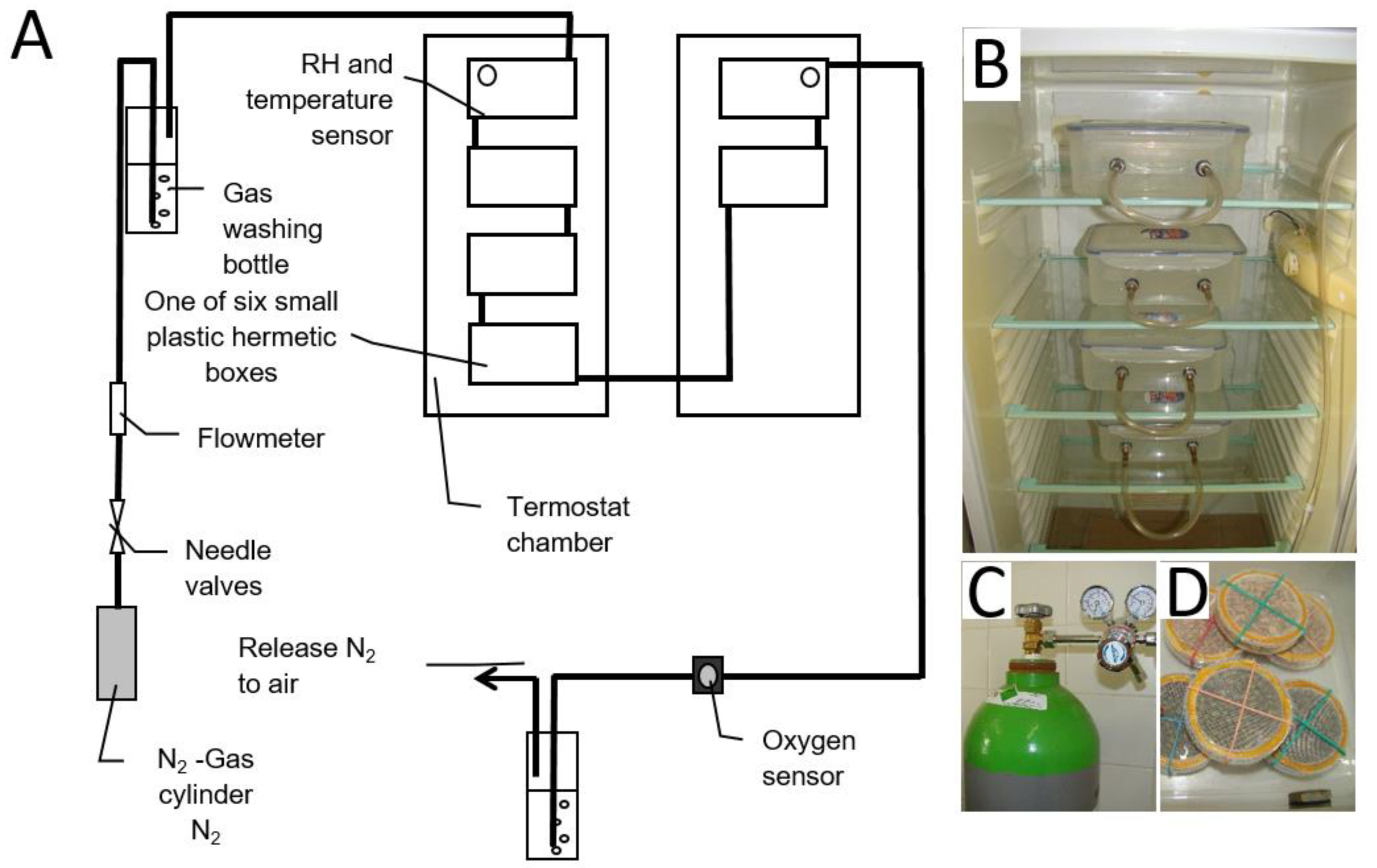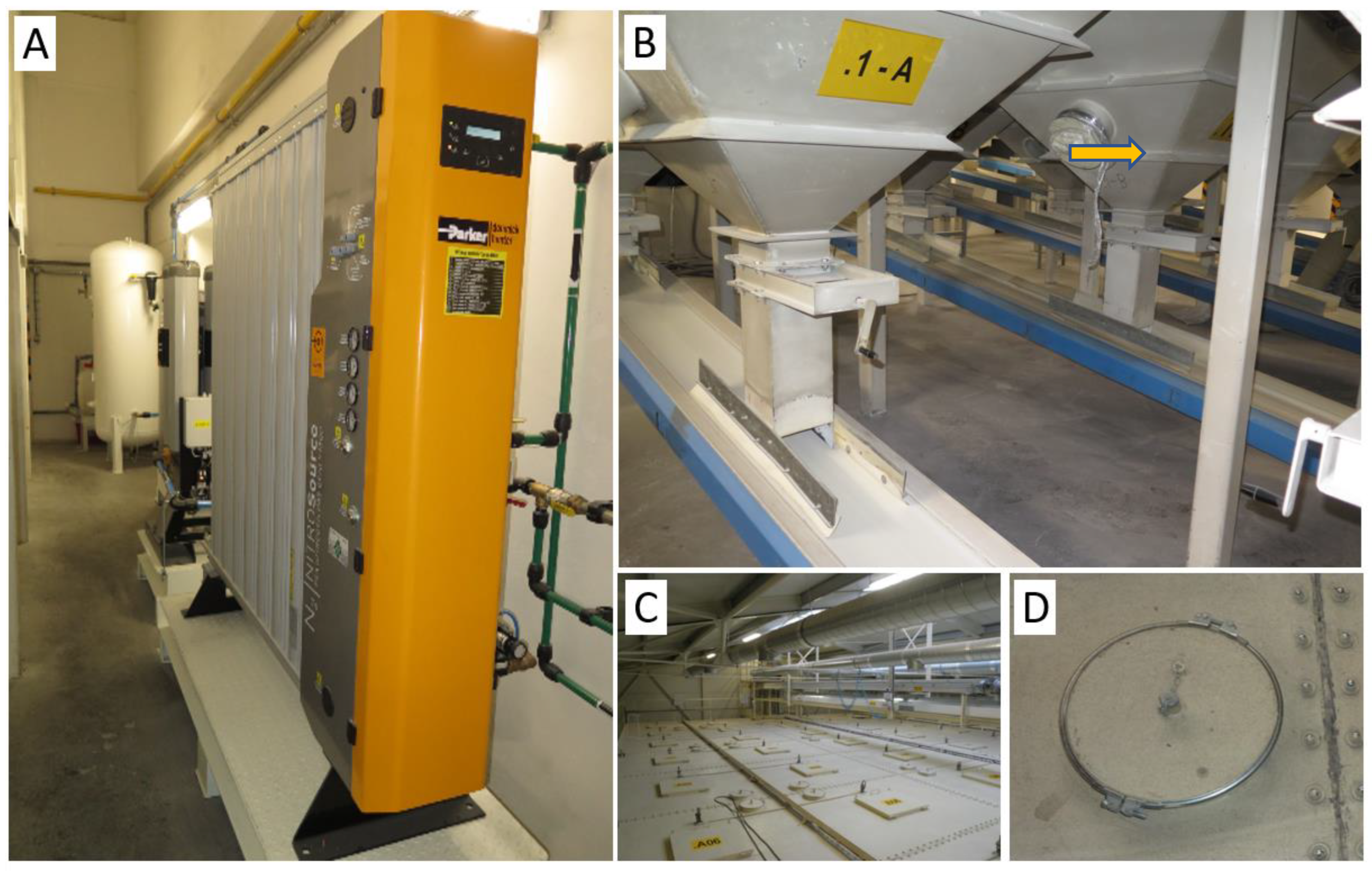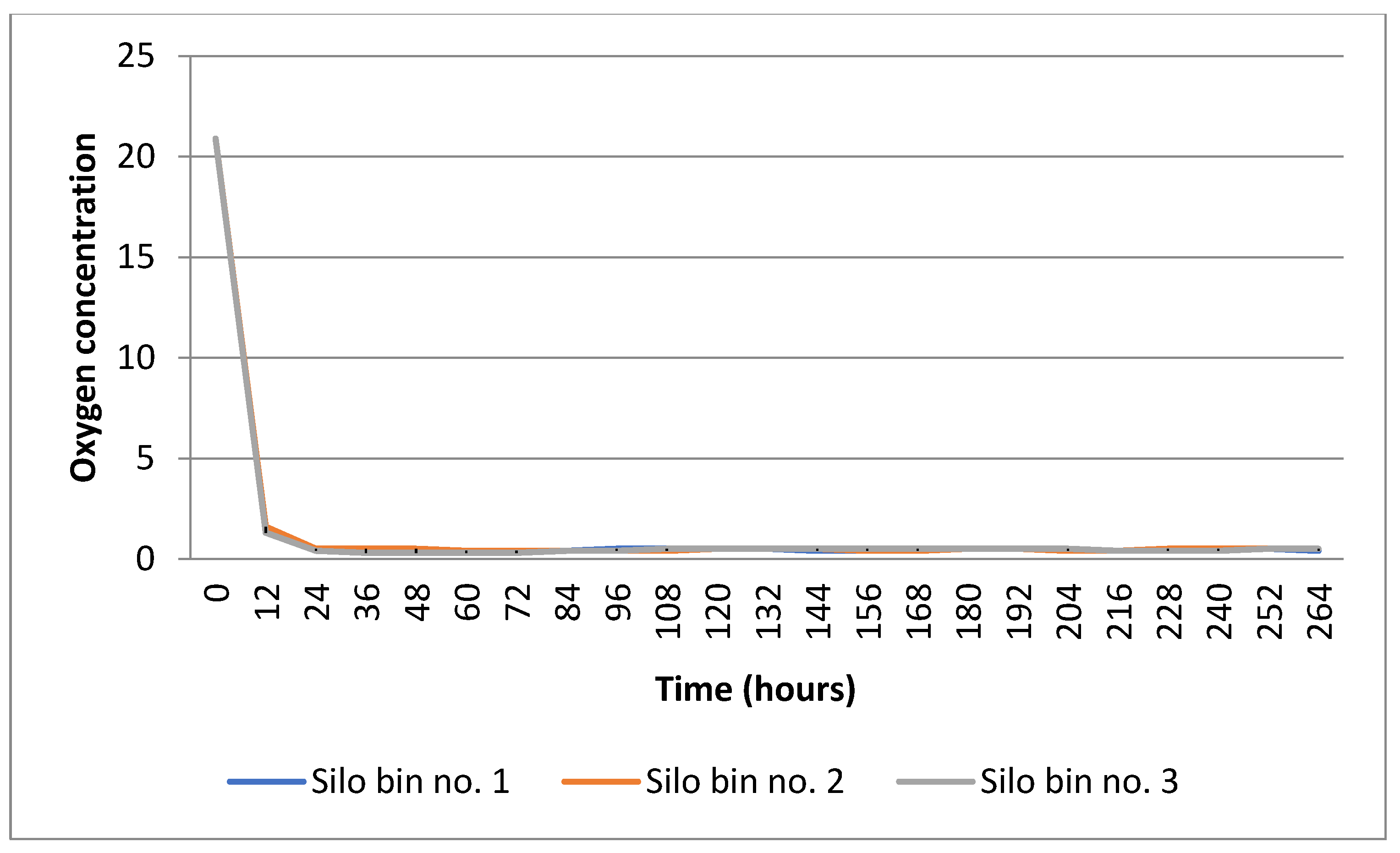Good technological practice for commodity storage on farms, and their onward export and import, requires the availability of robust, rapid and environmentally safe pest control procedures. Compared to toxic fumigants, the use of modified atmospheres (= controlled atmospheres or hermetic storage) is considered challenging in terms of the requirements for relatively long exposure times [
16,
17,
46,
47]. For a long-term storage of agricultural commodities at large farms or national strategic reserves facilities, the length of exposure to controlled atmospheres used in silos is usually not a major technological constraint [
26]. However, the length of exposure to controlled atmospheres can play a significant role in the short-term storage of commodities on small farms with limited storage capacity, in ports [
39], or in commercial organizations that process agro-commodities (cereals, rice, legumes, dry/dried fruits) into small food packages for retail sales [
44,
48]. For such companies, minimizing concentrations and exposure duration while achieving high efficacy is an essential constraint for the implementation of controlled atmospheres for routine practical use. This work therefore addressed the problem of optimization of the length of exposure by hypoxic nitrogen atmospheres for the control of two important storage pests, under laboratory and small-silos conditions.
4.1. Laboratory Trials
In the laboratory part of our work, new biological data were obtained regarding the biological efficacy of controlled nitrogen atmospheres on
C. chinensis and
S. granarius species under different exposure lengths (1–20 days) and different concentrations (95–100%). From a practical point of view, an important finding of our work was that for most of the tested exposures up to 20 days, the concentrations 99% and 100% nitrogen were highly effective for the control of all developmental stages (eggs, larvae, adult pupae) of both species. In contrast, at 95% nitrogen concentrations, 100% mortality was not achieved for all life stages of both species tested for most of the tested exposure times. The published work on laboratory exposures of
C. chinensis and
S. granarius with controlled atmospheres is relatively sparse [
49,
50,
51,
52,
53,
54,
55]. As a result, a direct comparison of our results with data from other authors is also relatively limited. Cui et al. [
49] investigated survival, development time delay and metabolomics changes in larvae (4
th instar) of
C. chinensis under two hypoxia regimes (2% O
2 = hypoxia or 2% O
2 + 18% CO
2 = hypoxia/hypercapnia). They found that the development of
C. chinensis was significantly suppressed by both hypoxia conditions and showed profound differences in metabolites between the treatment and control groups. Cui et al. [
49] concluded that
C. chinensis has high tolerance to hypoxia since some proportion of 4
th-instar larvae survived (i.e., emerged as adults after 24 days) more than 20 days under hypoxia/hypercapnia. In our experiments, we achieved 100% mortality of
C. chinensis larvae when exposed in nitrogen atmosphere 99% for 12 days. However, the larval survival and adult emergence of
C. chinensis was observed for all tested exposure times at 95% nitrogen atmosphere. Regarding
S. granarius, Lindgren and Vincent [
50] reported 95% mortality of
S. granarius adults after 5.3 day exposure by 100% nitrogen exposure (70 °F and 60–70% RH). Adler [
54] observed 99% mortality from 10 strains of
S. granarius in 6.6 days (20 °C and 75–99% nitrogen and 1% oxygen). The results by Adler [
54,
55] are comparable with the results obtained later by Conyers and Bell [
56] on the sensitive and resistant strains of
S. granarius (99.3–100% mortality, in 8 days at 99% nitrogen atmosphere- 50% RH and 20 °C), and with the results obtained in our study (100 % mortality in 8 days at 100% nitrogen atmosphere, in 12 days at 99% nitrogen atmosphere).
Although direct comparison with available literature on the tested species is limited, it is still interesting to compare our results with abundant publications concerning the effectiveness of controlled atmospheres on the related pest species. They mainly include
Callosbruchus maculatus [
44,
57,
58,
59,
60,
61,
62],
Acanthoscelides obtectus [
57,
63],
Sitophilus zeamais [
34], and
S. oryzae [
33,
35]. Comparisons of data on
C. chinensis and
S. granarius with data on related species allow further generalization of the biological effects of inert gases on pests [
24,
64], and thus the construction of generally applicable atmosphere-controlled technologies and procedures for stored product pests [
17]. Our laboratory data show that
C. chinensis and
S. granarius adults were the most susceptible developmental stages, which is in agreement with many findings obtained by other authors for several species of storage pests. For example, Hashem et al. [
63] found that hypoxia/hypercapnia effects were more severe in adult bruchids
A. obtectus, which led to 100% mortality after 3 days of exposure, but the full hatchability suppression required 7 days. However, for
S. zeamais, Williams et al. [
35] found that not only adult stages but also eggs were more sensitive to anoxia than larval and pupal stages. The comparison of our data with the previously published results also suggested that the tested species of internal-feeding pests might be less sensitive to controlled atmospheres compared to some species of externally-feeding pests, such as
Tribolium sp. and
Oryzaephilus sp. [
37,
44,
56,
65,
66]. For example, Sakka et al. [
44] found that
C. maculatus is more tolerant to nitrogen atmosphere than
T. castaneum. They hypothesized that the difference in their sensitivity could be because the immature development of
C. maculatus occurs in the inner part of the seeds, where nitrogen penetration may be more gradual, and the
T. castaneum individuals are more directly exposed to nitrogen. However, several authors have shown that some externally developing pests, such as
Cryptolestes spp. and
Trogoderma genera [
29,
44,
46,
56,
66], can exhibit tolerance to controlled hypoxic/anoxic atmospheres. For example, Conyers and Bell [
56] found that adults of
C. ferrugineus appeared to be most tolerant to an atmosphere with 1% oxygen, followed by
S. granarius, while adults of
O. surinamensis were the most sensitive. Moncini et al. [
33] reported that an atmosphere containing 98.5% N
2 caused the complete mortality of
S. oryzae adults after 3 days of exposure on wheat kernels, whereas the complete mortality of
T. confusum adults required 7 days on flour. This is surprising, because it was previously reported [
65] that externally developing
T. confusum was very sensitive to nitrogen atmosphere. In this case, the question is whether sensitivity may be influenced not only by pest species, but also by the type of food commodity, such as grain or flour [
33]. All the discrepancies found in the above-mentioned published works suggest that the affiliation of a particular species of a storage pest to an ecotype, with development inside or outside the seed commodity, is not a completely reliable predictor of its sensitivity or tolerance to anoxic/hypoxic atmosphere. In addition, the complex biotic and abiotic relationships discussed above indicate that practical procedures and exposure regimes for the use of a controlled atmosphere in practice should be more or less specific to each pest species.
Another practical objective of our laboratory work was to explore the mortality- concertation relationship in the tested species for the 95%-100% range of atmospheric nitrogen concentrations. Navarro and Navarro [
17] pointed out that effective nitrogen dosage and exposure must be relatively precise and within a certain range of concentrations, because mortality may not have a positive linear relationship with increasing nitrogen concentration over the entire range of values. The basis for this caveat was previous laboratory experiments conducted by Navarro [
40]. He found that, contrary to intuitive expectation, the necessary exposure time for some species increases when the atmospheric oxygen concentration approaches zero. In other species, however, 100% anoxia may be more effective than various levels of hypoxia. For example, Navarrro [
40] described that
Ephestia cautella pupae and
Tribolium castaneum adults reacted to increasing concentrations of N
2 in a similar pattern, whereas
S. oryzae adults reacted in a different way. The lower the oxygen concentration was, the shorter the exposure time needed to produce 95% mortality of
E. cautella pupae and
T. castaneum. However,
S. oryzae adults showed greater sensitivity at 1% oxygen than at the zero level of oxygen concentration. In our study, we found that responses to different oxygen concentrations differed not only between the two species tested, but also among developmental stages within a species. In
S. granarius, lethal exposure was shorter at 100% nitrogen concentration than at the lower concentration (99%), but the opposite was true for the pupal stage of this species. For the species
C. chinensis, the exposure time leading to 100% mortality was the same for the 99% and 100% concentrations, whereas for the immature stage, the exposure time leading to 100% mortality was higher for the lower of the two concentrations tested, 99%.
4.2. Field Validations
The required effective pest control exposures of commodities to hypoxic atmospheres can exceed one month, depending on the technological and environmental conditions in commodity stores and silos [
35]. However, such long exposure times may not be acceptable for many companies for operational and economic reasons [
44]. Users of controlled atmosphere usually balance between minimizing the length of the hypoxic exposure of infested commodities and maximizing its biological efficacy on pests. Unfortunately, practitioners frequently do not have detailed information to optimize these control processes for many pest species when controlling them in small silos. Most practical validations are either from large silos [
67,
68], laboratory small silos [
34], mini-silos [
35], glass desiccators [
56] or hermetic chambers [
44,
48]. Published data regarding the use of controlled atmospheres for the treatment of commodities in smaller silos (25t) is lacking, or is very limited [
35,
37,
69]. At the same time, detailed technological information is very important because the treatment of small silos is challenging; even small gas leaks cause a significant reduction in the concentration of inert gases [
17,
70]. For potential users, compensating for nitrogen leakage from silos by continuously saturating the silo-atmosphere with inert gases may seem economically and operationally demanding. However, our fieldwork has shown that good results can be achieved even in small metal silos in the normal operating conditions of a commercial commodity store (Podravka-Lagris, CZ). Our validations in these silos demonstrated that these types of silos could be saturated by the 98% nitrogen within 12 h, and a target hypoxic concentration above 99% can be well achieved within 24 h. It was further demonstrated that under a period of 10–20 days, a relatively stable level of over 99% nitrogen can be maintained; oxygen concentration oscillating between 0.3–0.7%. However, it should be noted that the treated silos were located indoors. Thus, the large fluctuations in temperature and the effects of direct sun-glare were reduced, that likely buffered large fluctuations in controlled atmosphere concentrations. Indeed, other authors have documented that the method of application, the type of facility and/or temperature/sunshine fluctuations can cause concentration fluctuations and uneven distribution of inert and toxic gases in treated stores, chambers and transport vehicles [
11,
44,
71,
72]. Regarding the importance of the necessity of an even concentration distribution of nitrogen in the treated chamber, Sakka et al. [
44] stressed that: “pest location is a crucial parameter that may determine the insecticidal effect of nitrogen. In our study, we saw that despite variations in insect survival in the different locations, some of the insects that survived we found in the vials that had been placed in the “heart” of the pallet. This is somehow expected, as nitrogen penetrates into the pallet from the outside to the inside, and thus, “oxygen nests” can be created in the internal part of the product mass.” From this point of view, it would be interesting to compare our results (concerning the stability and concentration variations of a controlled hypoxic atmosphere) with experiments carried out in small silos located outside shielded and tempered spaces, in the future experiments.
Concurrently with the validation of nitrogen filling and concentrations maintenance in the silos, bio tests were placed in the upper and lower parts of the silos. This is because our previous work [
37] revealed that there might be differences in the biological efficacy achieved between the top and bottom of the silo when filling silos by nitrogen from top to bottom, and using very short exposures. However, in the current validation experiments, it was shown that both exposure regimes (11 and 21 days) resulted—under given environmental conditions—in 100% control of all developmental stages of
C. chinensis and
S. granarius at both the top and bottom of the treated silos. Thus, these tests yielded optimistic results, acceptable for the use of relatively short exposure times of controlled atmospheres in small silos. On-site nitrogen production using a swing-pressure-generator is economically challenging; especially in the current global energy crisis. Thus, the energy savings made possible by short exposure times, and thus reduced nitrogen production needs, is a very important and timely result of this work for practice. However, we believe that the results obtained for
C. chinensis and
S. granarius still need to be validated for other species. Indeed, there is an experimentally supported suspicion that some species, such as
T. granarium, may be highly tolerant to hypoxic [
44,
46] and hyper-carbic [
46] atmospheres. To control resistant species such as
T. granarium, it will likely be necessary to increase the length of exposure, manipulate temperature/pressure [
48,
73], or use a combination of stressors such as radiation and controlled atmospheres [
29]. Other aspects that merit future research attention may be effects caused by differences in the sensitivity of different geographic strains of pests to anoxic and hypoxic atmospheres. The differences in the tolerance of different strains of pests to controlled atmospheres has been noted by Adler [
54] and Conveyers and Bell [
56], who reported differences in the responses to hypoxia of
S. granarius populations from different countries and geographic regions.













